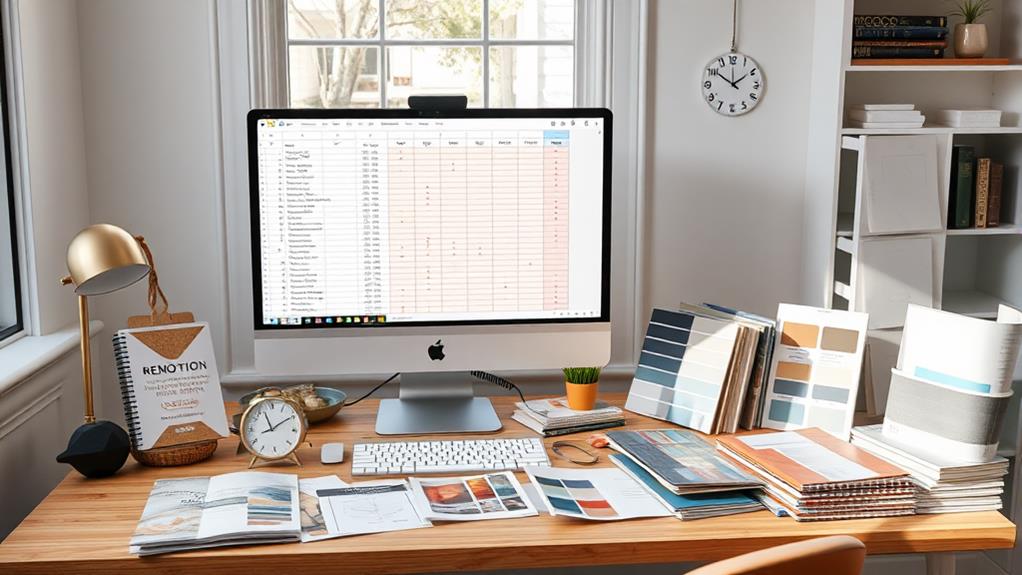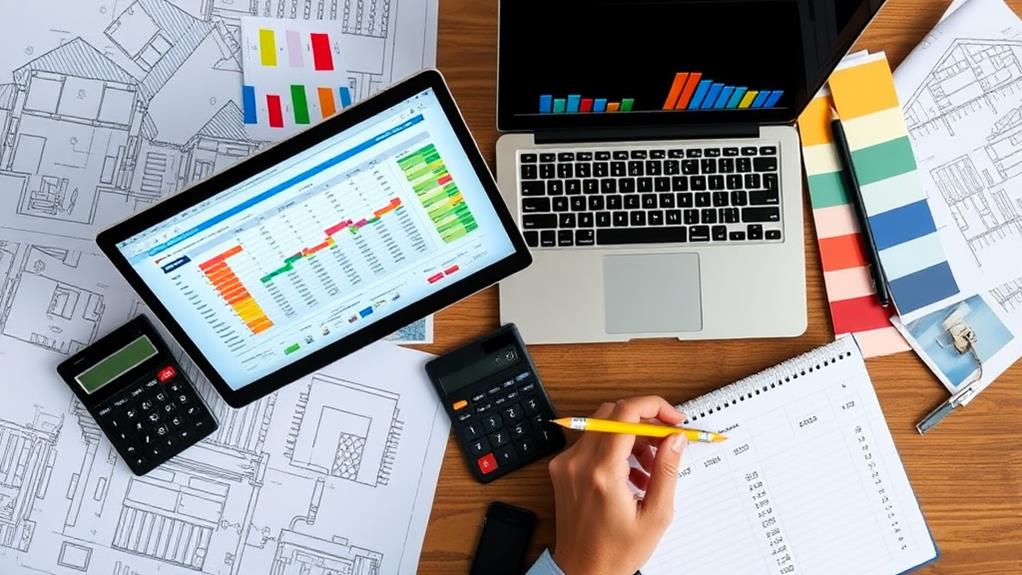Creating a detailed renovation budget spreadsheet involves several key steps. Start by gathering project information and defining the scope. Set up spreadsheet categories reflecting various aspects of the renovation, including subcategories for specific tasks. Research and estimate costs using multiple sources, factoring in regional variations and project complexity. Add a 10-20% contingency for unexpected expenses and include a section for potential extras. Regularly track and update the spreadsheet, comparing actual costs to initial estimates. This process helps manage expenses, identify discrepancies, and ensure project success. By following these steps, you'll be well-equipped to create a comprehensive budget that keeps your renovation on track.
Gather Project Information

Before creating a detailed renovation budget spreadsheet, it's essential to gather comprehensive project information. Start by clearly defining the scope of your renovation project, including all areas of the home that will be affected. Conduct a thorough assessment of the current condition of these areas, noting any structural issues or necessary repairs.
Next, create a list of desired changes and improvements for each space. This should include specific details such as materials, finishes, and fixtures you want to incorporate. Research local building codes and permit requirements to ensure compliance and factor in any associated costs.
Consult with contractors, architects, or designers to get professional input on the feasibility of your plans and potential challenges. Obtain detailed quotes from multiple service providers for each aspect of the project. This will help you compare costs and identify any discrepancies or overlooked elements.
Set Up Spreadsheet Categories
The foundation of a well-organized renovation budget spreadsheet lies in establishing appropriate categories. These categories should reflect the various aspects of your renovation project and allow for easy tracking of expenses. Begin by creating main categories such as demolition, structural work, electrical, plumbing, HVAC, flooring, painting, and finishes. Within each main category, include subcategories for specific tasks or materials.
For example, under "Electrical," you might have subcategories for wiring, fixtures, and labor. Include a separate category for permits and inspections, as these are often overlooked but crucial expenses. Create a contingency category, typically 10-20% of the total budget, to account for unexpected costs or changes.
Don't forget to include categories for design fees, project management, and any temporary living arrangements if necessary. As you set up these categories, consider the specific needs of your project and adjust accordingly. A well-structured spreadsheet will not only help you track expenses but also provide a clear overview of your renovation progress and financial status throughout the project.
Research and Estimate Costs

Diving into the research phase is crucial for accurate cost estimation in your renovation project. Begin by thoroughly investigating each category you've established in your spreadsheet. Utilize multiple sources to gather pricing information, including online retailers, local suppliers, and contractor quotes. For materials, consider factors like quality, durability, and aesthetic appeal to balance cost with value.
When estimating labor costs, consult with various professionals or use industry-standard pricing guides. Factor in regional variations and the complexity of your specific project. Don't forget to account for potential permits, inspections, and other regulatory requirements that may impact your budget.
For each item, record the lowest and highest prices you find to establish a realistic range. This approach helps you prepare for both best-case and worst-case scenarios. Remember to include often-overlooked expenses such as tool rentals, waste removal, and temporary living arrangements if necessary. As you research, maintain detailed notes on your findings, including sources and dates, to ensure your estimates remain current and verifiable throughout the planning process.
Add Contingency and Extras
With your initial cost estimates in place, it's time to incorporate contingency funds and account for potential extras in your renovation budget spreadsheet. A standard practice is to add a 10-20% contingency to your total budget to cover unexpected costs or unforeseen issues that may arise during the renovation process.
Create a separate section in your spreadsheet for contingency funds, clearly indicating the percentage and amount allocated. Next, consider potential extras that might enhance your renovation but aren't essential. These could include upgraded fixtures, additional storage solutions, or smart home features. List these items separately, along with their estimated costs, allowing you to prioritize and decide which to include based on your budget constraints.
Remember to update your contingency and extras sections regularly as you progress through your renovation. As some unexpected costs are resolved, you may be able to reallocate funds to desired extras. Conversely, if unforeseen expenses arise, you may need to adjust your plans for extras accordingly. This dynamic approach ensures your renovation budget remains flexible and realistic throughout the project.
Track and Update Regularly

Keeping tabs on your renovation budget is crucial for project success. Regularly tracking and updating your budget spreadsheet ensures you maintain control over expenses and can make informed decisions throughout the renovation process. Set a schedule to review your budget, ideally weekly or bi-weekly, depending on the project's duration and complexity.
During each review, update actual costs as they occur, comparing them to your initial estimates. This practice helps identify discrepancies early, allowing you to adjust your plans or reallocate funds if necessary. Pay close attention to any unexpected expenses or cost overruns, and document the reasons for these variances.
Use your spreadsheet to monitor the overall financial health of your project. Calculate the percentage of budget spent and remaining for each category and the project as a whole. This information can help you prioritize remaining tasks and make cost-cutting decisions if needed. Additionally, track any changes in the project scope and their impact on the budget. By consistently updating your spreadsheet, you'll maintain a clear picture of your renovation's financial status and be better equipped to complete the project within your desired budget constraints.
Frequently Asked Questions
How Do I Prioritize Renovation Projects Within My Budget?
To prioritize renovation projects within your budget, assess essential repairs first, then focus on improvements that add value to your property. Consider your lifestyle needs, return on investment, and long-term goals. Create a ranked list based on these factors.
Should I Hire a Professional Estimator for Complex Renovation Projects?
In the colossal world of renovations, hiring a professional estimator for complex projects can be a game-changer. Their expertise provides astonishingly accurate cost projections, minimizes financial surprises, and helps you make informed decisions about your renovation's scope and feasibility.
What Software Is Best for Creating and Managing Renovation Budget Spreadsheets?
For creating and managing renovation budget spreadsheets, popular software options include Microsoft Excel, Google Sheets, and specialized tools like BuilderTREND or CoConstruct. These platforms offer robust features for organizing, tracking, and analyzing project costs effectively.
How Do I Account for Potential Changes in Material Costs Over Time?
To account for potential changes in material costs over time, include a contingency percentage in your budget, regularly update pricing information, and consider using price escalation clauses in contracts with suppliers to mitigate unexpected cost increases.
Are There Industry-Standard Percentages for Contingency in Renovation Budgets?
Industry-standard contingency percentages for renovation budgets typically range from 10% to 20% of the total project cost. However, this can vary based on project complexity, scope, and risk factors. Experienced contractors may recommend specific percentages for your particular renovation.
Conclusion
In conclusion, a meticulously crafted renovation budget spreadsheet serves as an indispensable tool for financial stewardship during home improvement endeavors. By carefully assembling project details, establishing comprehensive categories, conducting thorough cost research, incorporating prudent contingencies, and maintaining vigilant oversight, homeowners can navigate the often tumultuous waters of renovation with greater confidence. This living document not only illuminates potential fiscal challenges but also paves the way for a more harmonious and fiscally responsible transformation of one's domestic sanctuary.

